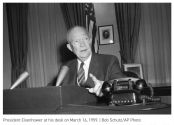Opinion | Assassinating Putin Won’t Work. It Never Has for America.
Amid calls to target Putin, it’s worth recalling why the U.S. has stopped trying to kill foreign heads of state.
Opinion by STEPHEN KINZER | POLITICO - 13 March 2022
Stephen Kinzer's new book is .
PART 2
On the morning of Aug. 18, 1960, Allen Dulles received an electrifying cable from the CIA station chief in the Congo, Larry Devlin. “Embassy and station believe Congo experiencing classic Communist effort takeover government,” it said. “Anti-West forces rapidly increasing power Congo and therefore may be little time left in which take action to avoid another Cuba.” Dulles took the cable to the Oval Office.
From 11:10 to 11:23 that morning, according to Eisenhower’s official calendar, he held an “off the record meeting” with Dulles and other CIA officers. After hearing their report, the note-taker wrote, the president “turned to Dulles and said something to the effect that LUMUMBA SHOULD BE ELIMINATED. There was stunned silence for about 15 seconds, and the meeting continued.” Senate investigators later pinpointed this moment as the point when Eisenhower “circumlocutiously” ORDERED PATRICE LUMUMBA’S ASSASSINATION.
What does a president do after giving such an order? Eisenhower posed for a photo with the departing Ecuadoran ambassador, had lunch, and then decamped to Bethesda for an afternoon of golf at Burning Tree Club. In case anyone missed the point, he sent his national security adviser, Gordon Grey, to the next meeting of the CIA’s covert action “special group” with instructions to convey “top-level feeling in Washington that vigorous action would not be amiss.”
A couple of weeks later, the CIA station chief in the Congo, Larry Devlin, received a cable from CIA headquarters telling him to expect a visit from an officer who would identify himself as “Joe from Paris.” When the officer arrived, Devlin recognized him as SIDNEY GOTTLIEB, the CIA’s POISON-MAKER. Gottlieb handed him a packet containing a vial of LIQUID BOTULINUM and told him he was to use it to kill Patrice Lumumba.
“Jesus H. Christ!” Devlin cried. “Who authorized this operation?”
“President Eisenhower,” Gottlieb told him. “I wasn’t there when he approved it, but Dick Bissell said that Eisenhower wanted Lumumba removed.” Then he helpfully added: “With the stuff that’s in here, no one will ever be able to know that Lumumba was assassinated.”
Devlin managed to organize a coup in which Lumumba was overthrown but not killed. He remained immensely popular both at home and abroad. Devlin’s efforts to penetrate his security ring and poison him, including an attempt to slip him a tube of tainted toothpaste, all failed. That didn’t discourage Allen Dulles. “We wish to give every possible support in eliminating Lumumba from any possibility of resuming government position,” he wrote in one cable. At one point Devlin and his officers considered using a “commando type group” to capture him. Then they asked if a sharpshooter with a “high powered foreign made rifle” could be found.
“Hunting good here when light’s right,” one CIA officer observed in a cable to headquarters.
The CIA’s poison ultimately went unused, but Devlin found another way to complete his mission. On November 27, Lumumba slipped out of the home where he was being held under Congolese and United Nations guard. Devlin set out to find and capture him. His key partners were intelligence officers FROM BELGIUM, the FORMER COLONIAL POWER, which had become fabulously wealthy by exploiting the CONGO’S MINERAL WEALTH. Together, they had Lumumba tracked, seized, tortured and delivered to his most murderous local enemies. A Congolese squad executed him under watchful Belgian eyes. No American was present.
Years later, an interviewer asked Allen Dulles if he regretted any of his operations. “I think that we overrated the danger in, let’s say, the Congo,” he replied. Devlin agreed.
“None of us had any real concept of what he stood for,” Devlin later wrote of Lumumba. “He was simply an unstable former postal clerk with great political charisma, who was leaning toward the Communist bloc. In Cold War terms, he represented the other side. The fact that he was first and foremost an African nationalist who was using the East-West rivalry to advance his cause was played down by the Belgians, who greatly feared him.”
When Eisenhower left office in January 1961, HE COULD COUNT ONE SUCCESSFUL ASSASSINATION — PATRICE LUMUMBA of Congo, in concert with the Belgians — AND TWO FAILURES: ZHOU ENLAI and FIDEL CASTRO. His successor, John F. Kennedy, focused intently on Castro. Especially after the spectacular failure of the 1961 Bay of Pigs invasion, he absorbed Eisenhower’s view that Castro must be “sawed off.”
“There was a flat-out effort ordered by the White House, the president, Bobby Kennedy — who after all was his right-hand man — to unseat the Castro government, to do everything possible to get rid of it by whatever device could be found,” former CIA director Richard Helms later told congressional investigators. The Kennedy administration sought relentlessly to kill Castro, even as it sent peace feelers to him through secret channels. On the very day President Kennedy was assassinated, a CIA officer in Paris passed a poison device to an operative who was to use it to kill Castro.
Kennedy also embraced another of Eisenhower’s Caribbean plots, aimed at the Dominican dictator RAFAEL TRUJILLO. Both presidents detested Trujillo and feared that his brutal rule might produce a Castro-style revolution. In July 1960, while Eisenhower was in office, the CIA delivered 12 “sterile” rifles with telescopic sights to anti-Trujillo plotters. Nine months later, with Kennedy in the White House, it delivered three carbines. The plotters carried out their tyrannicide on May 30, 1961. Democracy emerged a couple of years later, but the United States decided it could not tolerate that democracy because PRESIDENT JUAN BOSCH seemed too leftist and sympathetic to Castro. That led the United States to launch its 1965 INVASION of the DOMINICAN REPUBLIC and to stage-manage the election of a former Trujillo ally, JOAQUIN BALAGUER, who went on to dominate the country for much of the next 30 years.
The assassination that most tormented Kennedy was one that he set in motion but did not realize he had ordered. In a jumble of diplomatic missteps, and without a direct presidential command, the Kennedy administration authorized the overthrow of SOUTH VIETNAMESE PRESIDENT NGO DINH DIEM. On Nov. 1, 1963, assured of U.S. support, plotters carried out their coup and THEN ASSASSINATED NGO DINH DIEM.
“Kennedy leaped to his feet and rushed from the room with a look of shock and dismay on his face which I had never seen before,” General Maxwell Taylor, chairman of the joint chiefs of staff, later wrote of the moment when news of Diem’s death landed in the Oval Office. “He had always insisted Diem must never suffer more than exile, and had been led to believe or had persuaded himself that a change in government could be carried out without bloodshed.” This killing, the historian Staley Karnow wrote, “haunted US leaders during the years ahead, prompting them to assume a larger burden in Vietnam.”
Kennedy’s successor, Lyndon Johnson, embraced covert action, as have all modern American presidents, but did not emulate his two predecessors by authorizing assassination. The day after Kennedy was killed, he showed a visitor a portrait of Diem and said, “We had a hand in murdering him. Now it’s happening here.” Later Johnson wondered if Kennedy’s assassination was “divine retribution.” He also expressed disgust for the plots against Castro and Trujillo: “We were running a goddamn Murder Inc. in the Caribbean.”
AMERICANS ARE IMPATIENT BY NATURE. WE WANT QUICK SOLUTIONS, EVEN TO COMPLEX PROBLEMS. That makes killing a foreign leader seem like a good way to end a war. Every time we have tried it, though, we’ve failed — whether or not the target falls. Morality and legality aside, it doesn’t work. Castro thrived on his ability to survive American plots. In the Congo, almost everything that has happened since Lumumba’s murder has been awful.
Our record in carrying out REGIME CHANGE short of murder is hardly better. The CIA-directed overthrow of PRIME MINISTER MOHAMMAD MOSSADEGH in 1953 cast Iran into a political whirlwind from which it still has not escaped. A year later, the CIA coup against President Jacobo Arbenz of GUATEMALA aborted a ten-year democratic experiment and set that country on a path toward civil war and genocide.
Soon after the Guatemala coup, Eisenhower invited Allen Dulles and other CIA officers to the White House for official congratulations. They presented an elaborate account of their operation, complete with charts, slides, and film clips. Eisenhower had one question.
“Why the hell didn’t you catch Arbenz?” he asked.
“Mr. President,” came the reply, “that would have set a very dangerous precedent for you.”


